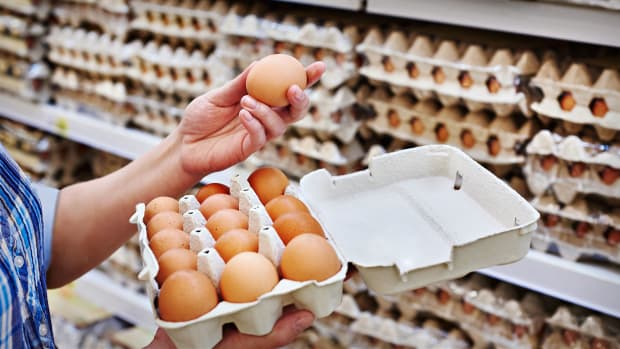
A carton of eggs has, for many people, become synonymous with food inflation.
The common breakfast and baking staple was subject to some of the most drastic price increases and, at one point in 2022, was 70% more expensive amid both an avian flu outbreak and food inflation in general.
DON'T MISS: Yes, Eggs Are Expensive. Here's Why And When Prices May Come Down
Heavily dependent on a given months' supply, egg prices are also highly volatile — according to the latest numbers from the Bureau of Labor Statistics, the average cost of eggs in the United States fell by 13.8% from April to May 2023.

Getty Images
Margarine, Flour and Sugar Prices Are All Still Spiking
While this marks the largest egg price drop in 72 years, the cost of food is still rising steadily. Groceries in May were 5.8% more expensive year-over-year while the cost of eating at a restaurant is up 8.3%.
Taken together, overall food prices rose 6.7% between May 2022 and 2023.
As every month, specific foods lead the pack with the biggest increases. In May, margarine was up 22.5% while the cost of flour and bread were up a respective 17.1% and 12.5%.
This summer is clearly not the best time to pursue one's interest in baking as the cost of another staple, sugar, also rose by a whopping 11.1%
Flour prices are particularly high because two common wheat varieties grown in the US, hard red winter and hard red spring, have faced decreased production due to drought. Many analysts expect the situation to worsen in the coming months as hotter weather sets in.
"The crop conditions we’re in have put a lot of attention on the potential of abandonment — acres that will not be harvested," Justin Gilpin, chief executive officer of Kansas Wheat, told Food Business News in April 2023.
Other baking staples like margarine and sugar are subject to factors ranging from the long-term effects of the pandemic on the supply chain to the war in Ukraine — the Eastern European country is a major producer of vegetable oils like sunflower and soybean.
Here Are the Food Staples That Actually Got Cheaper This Month
Regular butter was also subject to some pretty drastic price spikes throughout 2022 but, between April and May, fell by 1%.
Other foods to see lower prices include a citrus fruit such as lemons and oranges (5.3%), tomatoes (3.5%), and pork products such as roasts, steaks and ribs (7.3%). Bacon was another breakfast food that, in 2022, became synonymous with the worst of food inflation — between May 2022 and 2023, however, prices fell by 9.8% as months of sky-high increases started to stabilize.
While many baking staples have soared in prices, the overall picture is one of slow improvement. The consumer price index tracking inflation across all consumer categories was at 4%, the lowest increase seen since March 2021.
The 6.7% food price increase is a significant drop from peak 14.3% inflation seen in September 2022 although the rising cost of labor and transportation continue to pull the numbers upward from the other end.
"We expect a more noticeable deceleration in core prices in the coming months," Wells Fargo (WFC) Senior Economist Michael Pugliese told Reuters. "That said, directional progress should not be confused with mission accomplished. There is a lot of ground to cover in the inflation fight."
Sign up for Real Money Pro to learn the ins and outs of the trading floor from Doug Kass’s Daily Diary.







